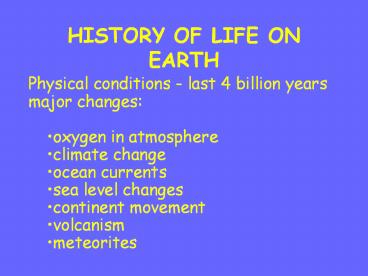HISTORY OF LIFE ON EARTH - PowerPoint PPT Presentation
Title:
HISTORY OF LIFE ON EARTH
Description:
HISTORY OF LIFE ON EARTH Physical conditions - last 4 billion years major changes: oxygen in atmosphere climate change ocean currents sea level changes – PowerPoint PPT presentation
Number of Views:479
Avg rating:3.0/5.0
Title: HISTORY OF LIFE ON EARTH
1
HISTORY OF LIFE ON EARTH
- Physical conditions - last 4 billion years
- major changes
- oxygen in atmosphere
- climate change
- ocean currents
- sea level changes
- continent movement
- volcanism
- meteorites
2
(No Transcript)
3
How do we know ages?
Relative ages of rock layers (sedimentary) their
relative positions their embedded fossils
4
How do we know ages?
Absolute ages radioisotopes carbon 14 - half
life of 5,700 y. less than 50,000
years potassium 40 - half life of 1.3 b.y. the
most ancient events
http//id-archserve.ucsb.edu/Anth3/Courseware/Chro
nology/09_Potassium_Argon_Dating.html
5
AGE DIVISIONS
Earths geological history is divided into eras
(eg. Cenozoic) and periods (eg. Cretaceous).
boundaries between units based on differences
between their fossil biotas Cenozoic 65 m.y.a.
to present Mesozoic 250-65 m.y.a. Paleozoic
550-250 m.y.a. Precambrian 550 m.y.a. to 4.5
b.y.a.
6
(No Transcript)
7
Crust movement
Continental drift Throughout Earths history the
continents have shifted, sometimes separating, at
other times colliding. Powered by radioactive
decay within the Earth!
8
(No Transcript)
9
(No Transcript)
10
(No Transcript)
11
(No Transcript)
12
Climate change (temperature)
volcanism sea level changes ocean
currents carbon dioxide levels ......dramatic
effects on the evolution of life
13
Sea level changes... up to 200 meters difference
14
Meteorite collisions also have changed conditions
on Earth. cause of abrupt mass extinction at
the end of the Cretaceous period (65 m.y.a) --
iridium -- Yucatan crater (180 km diameter)
15
Crater - in Yucutan Mexico Meterorite or
asteroid 10 miles in diameter 70 of living
species wiped out Debris blown into air caused
dramatic cooling- nuclear winter Global
firestorm from methane gas released from ocean
16
The Fossil Record
Importance Much of what we know about the
history of life on Earth comes from the study of
fossils.
17
The Fossil Record
Reveals broad patterns in the evolution of life.
Fossils show that many evolutionary changes are
gradual.
Incomplete but getting better...
18
The Fossil Record
19
The Fossil Record
20
The Fossil Record
21
Life in the Remote Past
The fossil record for Precambrian times is
fragmentary, but fossils from Australia show that
many animals that evolved disappeared
forever. Ediacara Hills
22
Life in the Remote Past
Diversity exploded during the Cambrian period.
The Cambrian Explosion. Why? All modern phyla
present ... and more chinese fossil beds
Burgess Shales
23
Life in the Remote Past
Hallucigenia
A phylum body plan that disappeared?
24
Rates of Evolutionary Change
Gradualism Punctuated equilibrium None?
Coelacanth ... more later molecular clock
25
Rates of Evolutionary Change
Mass extinctions (5 so far) 99 spp. have become
extinct, some during mass extinctions major
changes in flora and fauna subsequent radiations
after extinctions eg. Cenozoic radiations of
modern mammals
26
Patterns of Evolutionary Change
Cambrian - all major Animal body plans (phyla)
have evolved!
27
The Future of Evolution
The forces of evolution continue to operate
today eg. in humans West Nile Virus,
sexually transmitted diseases....
28
The Future of Evolution
Human intervention now plays an unprecedented
role in the history of life. Biodiversity crisis
- the sixth great extinction































